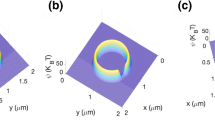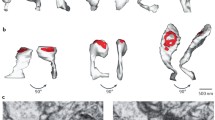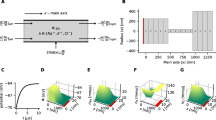Abstract
In this article, we elucidate the roles of divalent ion condensation and highly polarized immobile water molecules on the propagation of ionic calcium waves along actin filaments. We introduced a novel electrical triple layer model and used a non-linear Debye-Huckel theory with a non-linear, dissipative, electrical transmission line model to characterize the physicochemical properties of each monomer in the filament. This characterization is carried out in terms of an electric circuit model containing monomeric flow resistances and ionic capacitances in both the condensed and diffuse layers. We considered resting and excited states of a neuron using representative mono and divalent electrolyte mixtures. Additionally, we used 0.05V and 0.15V voltage inputs to study ionic waves along actin filaments in voltage clamp experiments. Our results reveal that the physicochemical properties characterizing the condensed and diffuse layers lead to different electrical conductive mediums depending on the ionic species and the neuron state. This region specific propagation mechanism provides a more realistic avenue of delivery by way of cytoskeleton filaments for larger charged cationic species. A new direct path for transporting divalent ions might be crucial for many electrical processes found in localized neuron elements such as at mitochondria and dendritic spines.












Similar content being viewed by others
Data Availability
Codes used for this study are publicly available from https://github.com/MarceloMarucho/TripleLayerModel.
References
Agarwal, A., & Hess, H. (2010). Biomolecular motors at the intersection of nanotechnology and polymer science. Progress in Polymer Science, 35(1), 252–277. Special Issue on Stimuli-Responsive Materials. ISSN: 0079-6700. https://doi.org/10.1016/j.progpolymsci.2009.10.007. https://www.sciencedirect.com/sciencea/article/pii/S0079670009001051
Bazant, M. Z., Chu, K. T., & Bayly, B. J. (2005). Current-voltage relations for electrochemical thin films. SIAM Journal on Applied Mathematics, 65(5), 1463–1484. https://www.jstor.org/stable/4096138
Cantiello, K. Z. H. F., & Patenaude, C. (1991). Osmotically induced electrical signals from actin filaments. Biophysical Journal, 59(6), 1284–1289. https://doi.org/10.1016/S0006-3495(91)82343-8
Cantiello, H., & Lin, E. C. (1993). A novel method to study the electrodynamic behavior of actin filaments. evidence for cable-like properties of actin. Biophysical Journal, 65(4), 1284–1289. https://doi.org/10.1016/S0006-3495(93)81188-3
Carnal, F., & Stoll, S. (2012). Explicit ions condensation around strongly charged polyelectrolytes and spherical macroions: The influence of salt concentration and chain linear charge density. Monte Carlo simulations. The Journal of Physical Chemistry A, 116, 6600–6608. https://doi.org/10.1021/jp3010019
Craddock, T. J. A., Tuszynski, J. A., & Hameroff, S. (2012). Cytoskeletal signaling: Is memory encoded in microtubule lattices by camkii phosphorylation? PLoS Computational Biology, 8(3), 1–16. https://doi.org/10.1371/journal.pcbi.1002421
Dhont, J. K. G., & Kang, K. (2011). Electric field induced polarization of the layer of condensed ions on cylindrical colloids. The European Physical Journal E, 34(4), 40.
Fall, C., Marland, E., Wagner, J., & Tyson, J. (2002). Computational cell biology. Interdisciplinary applied mathematics; v. 20. Springer, New York. ISBN: 0387953698
Frieden, B. R., & Gatenby, R. A. (2019). Signal transmission through elements of the cytoskeleton form an optimized information network in eukaryotic cells. Scientific Reports, 9(1), 6110. https://doi.org/10.1038/s41598-019-42343-2
Frieden, B. R., & Gatenby, R. (2020). Ion-based cellular signal transmission, principles of minimum information loss, and evolution by natural selection. International Journal of Molecular Sciences, 21(1). https://doi.org/10.3390/ijms21010009. https://www.mdpi.com/1422-0067/21/1/9
Ganguly, A., Tang, Y., Wang, L., Ladt, K., Loi, J., Dargent, B., et al. (2015). A dynamic formin dependent deep f-actin network in axons. Journal of Cell Biology, 210(3), 401–417. https://doi.org/10.1083/jcb.201506110
Gatenby, R. A. (2019). The role of cell membrane information reception, processing, and communication in the structure and function of multicellular tissue. International Journal of Molecular Sciences, 20(15). ISSN: 1422-0067. https://doi.org/10.3390/ijms20153609. https://www.mdpi.com/1422-0067/20/15/3609
Gerdes, H. H., Rustom, A., & Wang, X. (2013). Tunneling nanotubes, an emerging intercellular communication route in development. Mechanisms of Development, 130(6), 381–387. Neural Development. ISSN: 0925-4773. https://doi.org/10.1016/j.mod.2012.11.006. https://www.sciencedirect.com/science/article/pii/S0925477312001177
Hammond, C. (2008). Cellular and molecular neurophysiology. Elsevier/Academic Press, Amsterdam; 3rd ed. edition. ISBN: 9780123741271.
Hunley, C., & Marucho, M. (2017). Electrical double layer properties of spherical oxide nanoparticles. Physical Chemistry Chemical Physics, 19, 5396–5404. https://doi.org/10.1039/C6CP08174F
Hunley, C., Uribe, D., & Marucho, M. (2018). A multi-scale approach to describe electrical impulses propagating along actin filaments in both intracellular and in vitro conditions. RSC Advances, 8, 12017–12028.
Kanwore, K., Guo, X.-X., Abdulrahman, A. A., Kambey, P. A., Nadeem, I., & Gao, D. (2021). Sox1 is a backup gene for brain neurons and glioma stem cell protection and proliferation. Molecular Neurobiology, 37(5), 477–482. https://doi.org/10.1007/s12035-020-02240-6
Lamm, G., & Pack, G. R. (2010). Counterion condensation and shape within poisson boltzmann theory. Biopolymers, 93(7), 619–639. https://doi.org/10.1002/bip.21421. eprint: https://onlinelibrary.wiley.com/doi/pdf/10.1002/bip.21421. https://onlinelibrary.wiley.com/doi/abs/10.1002/bip.21421
Lange, K., & Brandt, U. (1996). Calcium storage and release properties of f-actin: evidence for the involvement of f-actin in cellular calcium signaling. FEBS Letters, 395(2–3), 137–142. https://doi.org/10.1016/0014-5793(96)01025-3. eprint: https://febs.onlinelibrary.wiley.com/doi/pdf/10.1016/0014-5793
Lavoie Cardinal, F., Bilodeau, A., Lemieux, M., Gardner, M. -A., Wiesner, T., Laramee, G., Gagne, C., & De Koninck, P. (2020) Neuronal activity remodels the f-actin based submembrane lattice in dendrites but not axons of hippocampal neurons. Scientific Reports. https://doi.org/10.1038/s41598-020-68180-2
Manning, G. S. (2007). Counterion condensation on charged spheres, cylinders, and planes. The Journal of Physical Chemistry B, 111(29), 8554–8559 PMID: 17388468. https://doi.org/10.1021/jp0670844
Manning, G. S. (2011). Counterion condensation on charged spheres, cylinders, and planes. The European Physical Journal E, 34(4), 39. https://doi.org/10.1140/epje/i2011-11039-2
Marucho, M. (2019). A java application to characterize biomolecules and nanomaterials in electrolyte aqueous solutions. Computer Physics Communications, 242, 104–119. ISSN: 0010-4655. https://doi.org/10.1016/j.cpc.2019.03.022. https://www.sciencedirect.com/science/article/pii/S0010465519301249
Marzo, L., Gousset, K., & Zurzolo, C. (2012). Multifaceted roles of tunneling nanotubes in intercellular communication. Frontiers in Physiology, 3, 72. https://doi.org/10.3389/fphys.2012.00072. https://www.frontiersin.org/article/10.3389/fphys.2012.00072
Ndzana, F. I., & Mohamadou, A. (2019). Exact solitary wavelike solutions in a nonlinear microtubule RLC transmission line. Chaos: An Interdisciplinary Journal of Nonlinear Science, 29(1), 013116. https://doi.org/10.1063/1.5044722
Newman, J. (1965). The polarized diffuse double layer. Transactions of the Faraday Society, 61, 2229–2237. https://doi.org/10.1039/TF9656102229
Oertner, T. G., & Matus, A. (2005). Calcium regulation of actin dynamics in dendritic spines. Cell Calcium, 37(5), 477–482. ISSN: 0143-4160. https://doi.org/10.1016/j.ceca.2005.01.016. https://www.sciencedirect.com/science/article/pii/S0143416005000333
Patolsky, F., Weizmann, Y., & Willner, I. (2004). Actin-based metallic nanowires as bio-nanotransporters. Nature Materials, 3(10), 692–695. https://doi.org/10.1038/nmat1205
Priel, A., Ramos, A. J., Tuszynski, J. A., & Cantiello, H. F. (2008). Effect of calcium on electrical energy transfer by microtubules. Journal of Biological Physics, 34(5), 475–485. https://doi.org/10.1007/s10867-008-9106-z
Ren, P., Chun, J., Thomas, D. G., Schnieders, M. J., Marucho, M., Zhang, J., & Baker, N. A. (2012). Biomolecular electrostatics and solvation: a computational perspective. Quarterly Reviews of Biophysics, 45(4), 427–491. https://doi.org/10.1017/S003358351200011X
Rosado, J. A., & Sage, S. O. (2000). The actin cytoskeleton in store-mediated calcium entry. The Journal of Physiology, 526(2), 221–229. https://doi.org/10.1111/j.1469-7793.2000.t01-2-00221.x. eprint: https://physoc.onlinelibrary.wiley.com/doi/pdf/10.1111/j.1469-7793.2000.t01-2-00221.x. https://physoc.onlinelibrary.wiley.com/doi/abs/10.1111/j.1469-7793.2000.t01-2-00221.x
Sartori-Rupp, A., Cordero Cervantes, D., Pepe, A., Gousset, K., Delage, E.,& Corroyer-Dulmont, S., Schmitt, C., Krijnse-Locker, J., & Zurzolo, C. (2019). Correlative cryo electron microscopy reveals the structure of TNTS in neuronal cells. Nature Communications, 10(1), 342. https://doi.org/10.1038/s41467-018-08178-7
Sataric, M. V., Ilic, D. I., Ralevic, N., & Tuszynski, J. A. (2009). A nonlinear model of ionic wave propagation along microtubules. European Biophysics Journal, 38(5), 637–647. https://doi.org/10.1007/s00249-009-0421-5
Sataric, M. V., Sekulic, D. L., & Sataric, B. M. (2015). Actin filaments as the fast pathways for calcium ions involved in auditory processes. Journal of Biosciences, 40(3), 549–559. https://doi.org/10.1007/s12038-015-9547-z
Sataric, M. V., Zdravkovic, S., Nemes, T., & Sataric, B. M. (2020). Calcium signaling modulates the dynamics of cilia and flagella. European Biophysics Journal, 49(7), 619–631. https://doi.org/10.1007/s00249-020-01471-8
Schubert, T., & Akopian, A. (2004). Actin filaments regulate voltage-gated ion channels in salamander retinal ganglion cells. Neuroscience, 125(3), 583–590. ISSN: 0306-4522. https://doi.org/10.1016/j.neuroscience.2004.02.009. https://www.sciencedirect.com/science/article/pii/S0306452204001162
Tuszynski, J., Portet, S., Dixon, J., Luxford, C., & Cantiello, H. (2004). Ionic wave propagation along actin filaments. Biophysical Journal, 86(4), 1890–1903. ISSN: 0006-3495. https://doi.org/10.1016/S0006-3495(04)74255-1. https://www.sciencedirect.com/science/article/pii/S0006349504742551
Tuszynski, J. A., Friesen, D., Freedman, H., Sbitnev, V. I., Kim, H., Santelices, I., et al. (2018). Microtubules as sub-cellular memristors. Scientific Reports, 10(1), 2108. https://doi.org/10.1038/s41598-020-58820-y
Tuszynski, J. A., Sataric, M. V., Sekulic, D. L., Sataric, B. M, & Zdravkovic, S. (2018). Nonlinear calcium ion waves along actin filaments control active hair bundle motility. Biosystems, 173:181–190. Computational, Theoretical, and Experimental Approaches to Morphogenesis. ISSN: 0303-2647. https://doi.org/10.1016/j.biosystems.2018.08.006. https://www.sciencedirect.com/science/article/pii/S0303264718302442
Wang, Y., Mattson, M. P., & Furukawa, K. (2002). Endoplasmic reticulum calcium release is modulated by actin polymerization. Journal of Neurochemistry, 82(4), 945–952. https://doi.org/10.1046/j.1471-4159.2002.01059.x. eprint: https://onlinelibrary.wiley.com/doi/pdf/10.1046/j.1471-4159.2002.01059.x. https://onlinelibrary.wiley.com/doi/abs/10.1046/j.1471-4159.2002.01059.x
Warshavsky, V., & Marucho, M. (2016). Polar-solvation classical density-functional theory for electrolyte aqueous solutions near a wall. Physical Review E, 93, 042607. https://doi.org/10.1103/PhysRevE.93.042607. https://link.aps.org/doi/10.1103/PhysRevE.93.042607
Zhou, J. C., Wang, X., Xue, M., Xu, Z., Hamasaki, T., Yang, Y., et al. (2010). Characterization of gold nanoparticle binding to microtubule filaments. Materials Science and Engineering: C, 30(1), 20–26. ISSN: 0928-4931. https://doi.org/10.1016/j.msec.2009.08.003. https://www.sciencedirect.com/science/article/pii/S0928493109002343
Funding
This work was supported by NIH Grant 1SC1GM127187-03.
Author information
Authors and Affiliations
Corresponding author
Ethics declarations
Ethics approval
Not Applicable
Consent to participate
Not Applicable
Consent for publication
Not Applicable
Conflict of interest
The authors declare no conflict of interest
Additional information
Communicated by Action Editor: Gaute T Einevoll.
Appendix
Appendix
1.1 Validation on the mean electrostatic potential approximation
In Figures 13a, b we display in green color the approximate mean electrostatic potential solution used in the diffuse layer for \([Ca]=50nM\) and \([Ca]=1mM\) calcium concentrations, respectively. For comparison purposes, we also include the orange and blue lines, which correspond to the exact nonlinear Debye-Huckel and the linear Debye-Huckel solutions, respectively.
1.2 Non trivial contributions to the longitudinal conductivity coming the the diffuse layer
The explicit expression for \(\Delta k_{l}^{DL}\) reads
where
and
1.3 Condensed layer capacitance parameters
The expressions for the parameters \(a_{0}\), \(a_{1}\), \(a_{2}\), and \(a_{3}\) are \(a_{0}\)\(=-\frac{L}{M+\frac{N}{2}}-\frac{L^{3}\,N\,\gamma ^{2}\,\zeta _{v}^{2}}{4(M+\frac{N}{2})^{3}\,(2M+N)}\), \(a_{1}=\frac{1}{M+\frac{N}{2}}+\frac{3L^{2}\,N\,\gamma ^{2}\,\zeta _{v}^{2}}{4(M+\frac{N}{2})^{3}\,(2M+N)}\), \(a_{2}=-\frac{3\ L\ N\,\gamma ^{2}\,\zeta _{v}^{2}}{4(M+\frac{N}{2})^{3}(2\,M+N)}\), and \(a_{3}=\frac{N\,\gamma ^{2}\,\zeta _{v}^{2}}{4(M+\frac{N}{2})^{3}(2\,M+N)}\), where \(M=\frac{4\,a\,\pi \,log(x_{c})}{\epsilon _{CL}}\), \(N=\frac{8\,a\,\pi }{\epsilon _{DL}\,\varepsilon _{DL}}\frac{K_{0}(\varepsilon _{DL}\,x_{c})}{K_{1}(\varepsilon _{DL})}\) and \(L=\frac{1}{8\,z_{p}\,\beta \,e}(x_{c}^{2}-1-2\,log(x_{c}))\varepsilon _{CL}^{2}\).
1.4 Impedance expression for the triple layer model
The expression for the impedance in the triple layer model reads
For \(R_{t}<<R_{l}\), this expression recovers the approximation \(Z\simeq 25.1128R_{l}\) used in our previous work on the EDL in which the transversal resistance was neglectable.
Rights and permissions
About this article
Cite this article
Hunley, C., Marucho, M. Electrical Propagation of Condensed and Diffuse Ions Along Actin Filaments. J Comput Neurosci 50, 91–107 (2022). https://doi.org/10.1007/s10827-021-00795-4
Received:
Revised:
Accepted:
Published:
Issue Date:
DOI: https://doi.org/10.1007/s10827-021-00795-4





